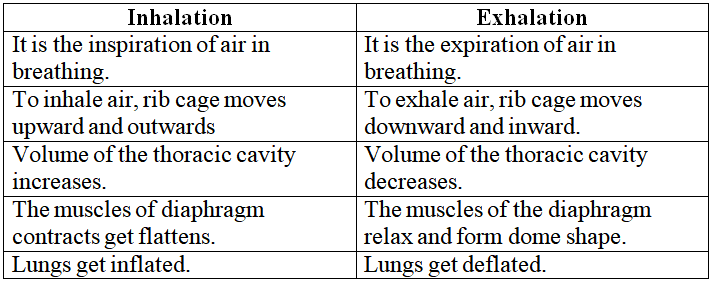Differentiate between inhalation and exhalation. ( Life Processes - Class 10 )
| Inhalation | Exhalation |
| What it means | |
| Intake of air into the lungs | Expelling air out of the lungs |
| Type | |
| Active process | Passive process |
| Size of the chest in the process | |
| Increases, expands | Decreases, reduces |
| Diaphragm – role | |
| Contracts, gets flattened by moving down | Relaxes, moves up forming a dome-shape |
| Intercostal muscle – role | |
| Relaxation of internal intercostal muscles and contraction of external intercostal muscles | Contraction of the internal intercostal muscles and relaxation of external intercostal muscles |
| Lungs – volume | |
| Rises to cause inflation | Reduces causing deflation |
| Action it causes | |
| Supply of oxygen-rich air to the blood | Carbon dioxide is expelled out |
| Air composition | |
| Inhaled air is a mix of oxygen and nitrogen | Exhaled air is a mix of nitrogen and carbon dioxide |
| Air pressure | |
| Decrease | Increase |
| Effect of intercostal muscles | |
| Ribcage moves upwards and outwards | Ribcage moves downwards |
- 1
Inhalation -
- Occurs through active contraction of the muscles such as the diaphragm and is the action of breathing in
- As part of the cycle of breathing, the process is autonomic and does not need conscious control
- It begins with the contraction of muscles attached to the ribcage causing expansion in the chest cavity, where contraction of the diaphragm sets in resulting in the expansion of the intrapleural space and a rise in the negative pressure as per Boyle’s law .
Exhalation -
- It is the act of exhaling air taken in and is passive
- Here, the diaphragm relaxes, moving upwards into the chest cavity
- The intercostal muscles between the ribs relax, causing the area of the chest cavity to reduce
- Eventually, the area in the chest reduces and carbon dioxide-rich air is expelled out of the lungs and windpipe, ultimately out of the nose .
- 1
inhalation: Inhalation (also known as inspiration) is the flow of the respiratory current into an organism. In humans it is the movement of air from the external environment, through the airways, and into the alveoli.
Exhalation:Exhalation (or expiration) is the flow of the respiratory current out of the organism. In humans it is the movement of air out of the bronchial tubes, through the airways, to the external environment during breathing.
- 1
| Inhalation | Exhalation |
| Inhalation is a process where you intake oxygen through the nostrils | Exhalation is breathing out carbon dioxide through the same airways. |
| During inhalation, the chest cavity increases in size due to the downward movement of the diaphragm | It occurs when the diaphragm moves up and the chest cavity becomes narrower |
| During inhalation, air from outside rushes into the lungs to fill the extra space. | During exhalation air comes out of the lungs to the atmosphere due to lack of space inside. |
- 1
| Inhalation | Exhalation |
| Inhalation is a process where you intake oxygen through the nostrils | Exhalation is breathing out carbon dioxide through the same airways. |
| During inhalation, the chest cavity increases in size due to the downward movement of the diaphragm | It occurs when the diaphragm moves up and the chest cavity becomes narrower |
| During inhalation, air from outside rushes into the lungs to fill the extra space. | During exhalation air comes out of the lungs to the atmosphere due to lack of space inside. |
- 1



